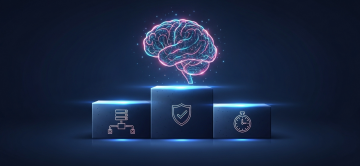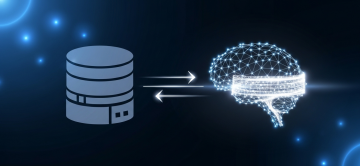A Deep Dive into LangGraph for Self-Correcting AI Agents

Beyond ReAct: A Deep Dive into LangGraph for Building Stateful, Self-Correcting AI Agents
The ReAct (Reason + Act) pattern was a foundational breakthrough for AI agents, proving that LLMs could use tools to interact with the world. By chaining together thought and action, we built agents that could answer questions and perform simple tasks. But as we move from simple demos to complex, production-grade applications, the linear, single-path nature of ReAct is revealing its limitations.
The critical "why": Real-world problems are rarely linear. They require iteration, revision, and dynamic adaptation. A simple ReAct agent that makes a mistake often plows ahead, unable to backtrack or revise its plan. It lacks true statefulness and the ability to self-correct. To build truly robust agents, we need to move from thinking in chains to thinking in graphs. At ActiveWizards, we use LangGraph to engineer this next generation of stateful, self-correcting agents. This article is a deep dive into the 'how' and 'why' of this powerful paradigm.
The Limits of Chains: Why ReAct Falls Short
The ReAct pattern is essentially a loop: the LLM reasons about what to do next, chooses a tool (the "Act" step), executes it, observes the result, and repeats. This is powerful but inherently linear. It's like a developer writing code from top to bottom without ever going back to fix a bug. This leads to common failure modes:
- Inability to backtrack: If an agent takes a wrong turn, it has no native mechanism to revert its last step and try a different approach.
- Difficulty with iteration: Tasks that require refinement (e.g., "write a report, then revise it based on feedback") are clumsy to implement.
- Poor state management: Passing complex state between steps is difficult, often leading to agents that are forgetful or context-unaware.
LangGraph: Thinking in Cycles, Not Lines
LangGraph, a library built on top of LangChain, fundamentally changes the agent paradigm. Instead of defining a linear chain of events, you define a stateful graph with nodes and edges. This allows for complex, cyclical workflows that are impossible with standard chains.
The core concepts are:
- State: A shared object that persists across the entire graph execution. This is the agent's memory.
- Nodes: The "workers" in the graph. Each node is a function or a callable LangChain object that modifies the state.
- Edges: The "wires" that connect the nodes, defining the flow of control.
- Conditional Edges: The "brains" of the graph. These are special edges that route the flow to different nodes based on the current state, enabling loops, branches, and self-correction.
Architectural Pattern: The "Generator-Critic" Self-Correction Loop
Let's make this concrete. A powerful pattern for building self-correcting agents is the "Generator-Critic" loop. The agent generates a piece of work, and a separate "critic" node evaluates it. If the work is unsatisfactory, the flow is routed back to the generator for another attempt.
Step 1: Define the State
The state is the shared memory. It holds the problem description, the generated answer, and any feedback for correction.
from typing import TypedDict, List
class AgentState(TypedDict):
problem_statement: str
current_answer: str
critique_history: List[str]
revision_number: int
Step 2: Define the Nodes (Generator and Critic)
The **Generator** node takes the `problem_statement` and `critique_history` and produces a `current_answer`. The **Critic** node takes the `current_answer` and decides if it's sufficient. If not, it adds a new critique to the `critique_history`.
Step 3: Define the Graph and the Conditional Edge
This is where the magic happens. We wire the nodes together and create a conditional edge that decides whether the process is finished or needs another revision.
Diagram 2: The flow of a self-correcting Generator-Critic loop in LangGraph.
# Conceptual graph definition
from langgraph.graph import StateGraph, END
# Define the nodes (generator_node, critic_node)
# ...
# Define the routing logic for the conditional edge
def route_after_critique(state: AgentState):
if "NEEDS_REVISION" in state["critique_history"][-1]:
return "generator" # Loop back to the generator
else:
return END # Finish the process
# Build the graph
workflow = StateGraph(AgentState)
workflow.add_node("generator", generator_node)
workflow.add_node("critic", critic_node)
workflow.set_entry_point("generator")
workflow.add_edge("generator", "critic")
workflow.add_conditional_edges(
"critic",
route_after_critique,
{"generator": "generator", END: END}
)
app = workflow.compile()
Chains are easy to debug; graphs are not. A complex LangGraph with multiple cycles and conditional paths can become a "black box" very quickly. In any production setting, integrating with an observability platform like LangSmith is non-negotiable. It allows you to visualize the execution trace of your graph run, inspect the state at each step, and understand why a particular path was taken. Without this level of insight, debugging and improving your agent becomes a painful exercise in trial and error.
Production Considerations
Building a LangGraph agent that is robust enough for production requires thinking beyond the core logic:
- Cycle Termination: What prevents an agent from getting stuck in an infinite correction loop? Your state must include a counter (like `revision_number`) and your conditional logic must force an exit after N attempts.
- Cost and Latency: Each cycle is another LLM call, which costs money and time. Design your prompts and critique mechanisms to be as efficient as possible to resolve issues in the fewest steps.
- State Persistence: For long-running, multi-user interactions, where does the agent's state live? You may need to compile the graph with a persistent checkpointer (e.g., backed by Redis or a SQL database).
- Tool Safety: Ensure that any tools called by nodes in the graph are secure, idempotent where necessary, and have proper error handling.
The ActiveWizards Advantage: From Simple Chains to Enterprise-Grade Agents
The transition from linear chains to cyclical graphs is the leap from toy agents to powerful, autonomous systems. LangGraph provides the toolkit, but designing efficient, robust, and observable agentic workflows is a complex engineering discipline. It requires a deep understanding of state management, control flow, and production-level system design.
At ActiveWizards, we specialize in this discipline. We architect and build the sophisticated, stateful AI agents that can tackle your most complex business challenges, moving beyond simple automation to create truly intelligent systems.
Engineer Your Next-Generation AI Agent
Ready to build AI agents that can reason, iterate, and self-correct? Partner with our experts to design and implement a robust, production-grade agentic workflow using LangGraph and advanced AI engineering principles.



Comments (0)
Add a new comment: